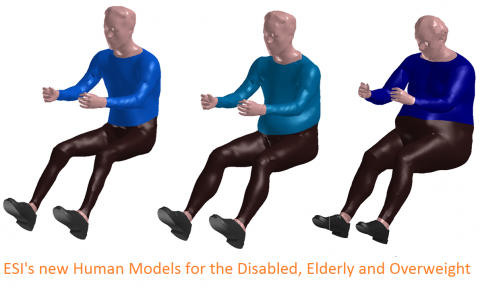ESI Releases Virtual Seat Solution 2017 to Address the Challenges of Automotive and Aircraft Seat Manufacturing
Paris, France – October 3, 2017 – ESI Group is a leading innovator in Virtual Prototyping software and services for manufacturing industries, announces the release of ESI Virtual Seat Solution 2017, the only software on the market specifically designed for the virtual prototyping of seats in the aeronautics and ground transportation industries. The software solution empowers OEMs (Original Equipment Manufacturers) and seat suppliers to design, test, improve and pre-certify their seat prototypes, fully and virtually, without the need for costly physical prototypes. Not only do these industrial clients save cost and time, they are also able to deliver highly innovative lightweight seats, while ensuring all aspects of their performance.
Seat quality requirements are higher than ever before, and engineers must meet those demands by offering seats that are safe, lightweight, and comfortable. In the latest release of Virtual Seat Solution 2017, ESI has extended the software’s capabilities to support important safety standards and help engineers take into consideration a rich diversity of seat occupants.
Certification and comfort of aircraft seat
When you design and engineer a disruptive seating solution in the aeronautic industry, ensuring the 16G EASA and FAA certification is one of the main challenges. Using ESI Virtual Seat Solution is a powerful way for us to evaluate the performance of our seat and anticipate the issues at a lower cost and much faster than any usual time-consuming test with expensive prototypes. We can virtually test different designs and material alternatives, and iterate as many times as necessary to succeed in the virtual pre-certification of the seat. By avoiding the time loss and the associated cost to correct an unsuccessful real test, we have managed to drastically reduce the time to market of our TiSeat,” commented Benjamin Saada, CEO of Expliseat.
The dedicated aeronautic version of Virtual Seat Solution 2017 offers a fully guided Head Impact Criteria (HIC) process, addressing one of the most challenging pre-certification tests. This 2017 version not only simplifies the dynamic testing set-up and analysis, but it also gives more precise results, thanks to accurate positioning of the Hybrid II dummy and new functionalities such as harness definition. All this enables seat and interior engineers to perform in a few clicks the virtual design iterations they need to succeed in their seat certification.
Aside from seat certification, Virtual Seat Solution 2017 offers dedicated functionalities and human models for the assessment of comfort and living space. In this version, ESI has extended its human model library to include elderly, overweight, and disabled people and thereby enables evaluation of the comfort of the seat for a wide range of passengers. ESI presented these new models and their application on a virtual prototype of Zodiac Seat Z301 at the Digital Human Modeling Symposium last June in Bonn, Germany.
Thermal Comfort and H-Point Optimization for automotive seats
While heated and cooled seats used to be integrated only in luxury cars, a wider range of carmakers now provide such seats for their midrange market as well. For electric and hybrid vehicles, manufacturers increasingly use these types of seats to help manage total energy consumption. The design of heated seats, as well as their optimization to effectively increase the thermal comfort of the occupant, can be very complex. Each of the interactions between the occupant, the seat cover, the cushion foam, and the heating system has to be taken into account. Furthermore, it is necessary to address the perceived and highly subjective thermal comfort of the occupant. Human models embedded in Virtual Seat Solution 2017 include human thermal modeling and thermal comfort criteria, which are needed to evaluate the effect of a heated seat on the comfort of its occupant. This version also incorporates dedicated functionalities for the heating pad and thermostat design of the seat.
Though it is now standard, H-Point prediction and its optimization are still challenging, especially for innovative seat designs. This latest release of Virtual Seat Solution makes it easier, thanks to dedicated foam material optimization tools.
Seat engineers are now able to design more innovative products by quickly and efficiently exploring creative concepts. The core of this new version is to maintain cost and time effectiveness while offering the best possible seat for every passenger.
For more information on Virtual Seat Solution, please visit: www.esi-group.com/products/virtual-seat-solution
For more ESI news, visit: www.esi-group.com/company/news
ESI Group – Media Relations
Delphine.AvomoEvouna [at] esi-group.com (Delphine Avomo Evouna)
+33 1 41 73 58 46
